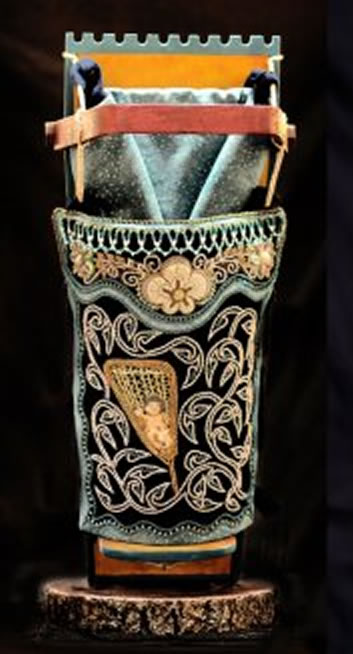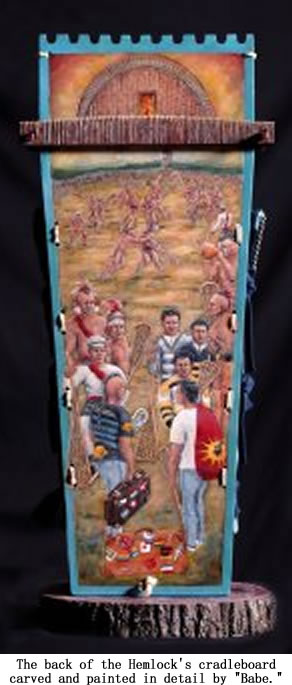 |
Canku Ota
|
 |
|
(Many Paths)
|
||
|
An Online Newsletter
Celebrating Native America
|
||
|
February 2015 - Volume
13 Number 2
|
||
|
|
||
|
How Lacrosse Came
To The Haudenosaunee
|
||
|
by Art Coulson (Cherokee)
- Native Peoples Magazine
|
||
|
The story of
the Creator's game is told through an award-winning cradleboard.
For now, the cradleboard that tells the story of the Creator's game remains in the Kahnawake home of the Mohawk couple who created it. Hand carved and painted on one side by Donald "Babe" Hemlock, and sewn and beaded by his wife, Carla, on the other, the award-winning cradleboard's designs show how lacrosse came to the Haudenosaunee, its place in settling disputes for centuries, and the way the Iroquois Nationals, a professional lacrosse team, assert tribal sovereignty through their prominence in the sport on the international scene. Like belts woven with patterns of wampum, the cradleboard is aesthetically beautiful, documents an important story, and is functional, meaning it can be used as a part of the life and culture of the Haudenosaunee (or Iroquois people). "I can still hear some of the older ones give reminders that we should not become a ‘culture under glass.' They would say if you make something, enjoy it, use it, pass it on and do not let it die," Carla says."Today, I still make functional work as well as work that will give a voice to an issue." The cradleboard fits both descriptions.
It also carries personal elements for the Hemlocks that have led them to keep the piece in the family for now: The beaded image of a newborn on the front side of the board was inspired by a photo of a baby in the family, and the theme of Native self-determination illustrated on the back ties into both a tribal and family story. While other pieces the couple have created have been acquired by museums and private collectors, that won't be the case for this cradleboard just yet. "Our family had an instant attachment to this board and asked us to hang onto it for a while," Carla says. "Where it will end up, we do not know."… "I can still hear some of the older ones give reminders that we should not become a ‘culture under glass.' They would say if you make something, enjoy it, use it, pass it on and do not let it die." The cradleboard, titled "Continuing the Legacy," has garnered awards at both the Santa Fe Indian Market (Best in Division and Best in Class for Diverse Arts in 2013) and the Heard Museum Guild Indian Fair & Market (two judges' awards and Best of Division recognition in 2014). This coming winter, it will be showcased in the Heard's upcoming exhibit Beautiful Games: American Indian Sport and Art, where it will appear on loan starting in December. "It shows a continuum of sport and the reverence a community has toward what is now called sport but originally had many ritual and ceremonial overtones," says Marcus Monenerkit (Comanche), the assistant curator at the Heard Museum who will oversee Beautiful Games. "The front of the cradleboard exemplifies how important lacrosse is to the Haudenosaunee …. The back of the cradleboard is a carving, which depicts early games and details the movement of the game through time."
Lacrosse is more than a game to the Haudenosaunee. Lacrosse is a ceremony given to them by the Creator to be played for his amusement, to settle disputes and to heal the sick. The Creator's game is used to bring balance back to a person, community or nation, to return them to the "good mind" that is central to the Haudenosaunee worldview. Haudenosaunee boys are often given wooden lacrosse sticks in the cradle shortly after birth, beginning a lifelong connection with the game. As Oren Lyons, an Onondaga Faithkeeper and honorary chairman of the Iroquois Nationals, puts it, lacrosse is "the lifeblood of the Six Nations." The Haudenosaunee and many other Native nations in the East and Midwest have been playing lacrosse for hundreds, if not thousands, of years. Traditional forms of the game, including the stickball of the Cherokee, Creek and Choctaw and the baaga'adowe of the Ojibwe, are still played alongside the modern game in tribal communities. "The top portion of the wrap is done in the style of our Mohawk raised beadwork to honor our old ways," she says. "I had finished the top portion and was now trying to figure out how I was going to blend a contemporary design into the wrap. Attending a family gathering, my niece gave me a photo. In the pocket of a goalie lacrosse stick sat the newest member of the extended Hemlock family. The timing could not have been more perfect. I asked for [my niece's] permission to use the photo, and that became the inspiration for the design." Often, newborns in the Hemlocks' community are placed in the net of a lacrosse stick to bestow on them the qualities of strength, endurance and tenacity. At the top of the painting on the back side of the board, there's a longhouse with a fire burning inside. Historical images of Iroquois men playing one another give way to illustrations of younger, contemporary players competing in an international arena."You can see how their sticks change along with their dress," says Babe, a former ironworker. "At the bottom are the younger guys, the young men today with their travel bags. The younger guys have their backs to us and are facing a path that has been opened for them." Those younger men are members of the Iroquois Nationals, the only American Indian national team sanctioned to play in any sport internationally. The Nationals were admitted to the International Lacrosse Federation in 1990 and are ranked in the top five in the Federation of International Lacrosse. Their travel bags in Babe's drawing carry stickers from the countries where they traveled on their own tribal documentation. The Haudenosaunee Confederacy has been issuing passports to its citizens since at least 1923, when Cayuga statesman Deskaheh traveled to the League of Nations in Geneva. The modern version of the Haudenosaunee passport has been in use since 1977, but that use has not been without controversy. In 2010, the team was preparing to travel overseas for the World Lacrosse Championships, but just before their departure, they were told that their Haudenosaunee passports would not be accepted. They would have to travel on either U.S. or Canadian documentation. The Nationals drew widespread media attention as they remained in New York, refusing to travel on anything but the documentation of their own tribal nation. In the end, they were denied entry into the United Kingdom, which cost them the chance to participate in the World Lacrosse Championships that year. "That same year, one of our sons had traveled to Bolivia with two other men from our community to attend an international conference on the environment," Babe says. "They had no problems traveling to Bolivia on their Haudenosaunee passports, but upon their return home, they were detained in El Salvador for close to a month. Both the United States and Canada refused to allow them entry." These two events, united by issues of sovereignty and Native self-determination, inspired the Hemlocks, who have created other works highlighting traditional and contemporary Iroquois culture. The artists, married 32 years, say they draw artistic inspiration from those who have gone before them, but it's also clear their inspirations are quite varied. Carla, who owns the craft shop Calico Cottage in Kahnawake, a Mohawk community that sits across the St. Lawrence River from Montréal, learned to make quilts, ribbon shirts and beaded pieces from the women in her family, like her mother. "I grew up in a home where my mother was always making something. She was never idle and had a work ethic that I must have inherited," she says. "My mother's grandmother was the quilter —always had on an apron with two pockets. One pocket held her scissors and the other held all the scraps of clothing that she was cutting up to use for a quilt. So early on, it was just normal for me to be around women that were constantly doing something creative." Babe traces his artistic influence to something not so traditional: Stan Lee and Marvel Comics. "From my earliest memory, I was always buying comics. I would always bother one of my brothers to draw Spider-Man for me. He finally got fed up with me and told me to do it myself," he says. You can see the comics' influence in the lacrosse images painted onto the cradleboard. No matter the source of their artistic inspiration, it is clear that their work, created individually and as a team, gives the Hemlocks great satisfaction. "There is a personal joy in seeing a newborn baby wrapped in one of your quilts, or to see your family wearing their traditional clothing in the Longhouse," Carla says. Art Coulson (Cherokee Nation of Oklahoma) is a veteran journalist and player of both lacrosse and Cherokee stickball. He lives in the Twin Cities. His children's book, The Creator's Game: A Story of Baaga'aadowe/Lacrosse, was published in November by Minnesota Historical Society Press. |
|
|
|
||
|
|
||
| Canku Ota is a free Newsletter celebrating Native America, its traditions and accomplishments . We do not provide subscriber or visitor names to anyone. Some articles presented in Canku Ota may contain copyright material. We have received appropriate permissions for republishing any articles. Material appearing here is distributed without profit or monetary gain to those who have expressed an interest. This is in accordance with Title 17 U.S.C. Section 107. | ||
|
Canku Ota is a copyright ©
2000 - 2014 of Vicki Williams Barry and Paul Barry.
|
||
 |
 |
|
|
The "Canku
Ota - A Newsletter Celebrating Native America" web site and
its design is the
|
||
|
Copyright ©
1999 - 2014 of Paul C. Barry.
|
||
|
All Rights Reserved.
|
||

 On
the front side of the cradleboard, where the newborn baby would
lie, Carla mixed the past with the present.
On
the front side of the cradleboard, where the newborn baby would
lie, Carla mixed the past with the present. The
Hemlocks quickly felt a family connection to the team's dilemma.
The
Hemlocks quickly felt a family connection to the team's dilemma.